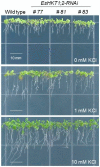Role and Functional Differences of HKT1-Type Transporters in Plants under Salt Stress
- PMID: 30823627
- PMCID: PMC6429402
- DOI: 10.3390/ijms20051059
Role and Functional Differences of HKT1-Type Transporters in Plants under Salt Stress
Abstract
Abiotic stresses generally cause a series of morphological, biochemical and molecular changes that unfavorably affect plant growth and productivity. Among these stresses, soil salinity is a major threat that can seriously impair crop yield. To cope with the effects of high salinity on plants, it is important to understand the mechanisms that plants use to deal with it, including those activated in response to disturbed Na⁺ and K⁺ homeostasis at cellular and molecular levels. HKT1-type transporters are key determinants of Na⁺ and K⁺ homeostasis under salt stress and they contribute to reduce Na⁺-specific toxicity in plants. In this review, we provide a brief overview of the function of HKT1-type transporters and their importance in different plant species under salt stress. Comparison between HKT1 homologs in different plant species will shed light on different approaches plants may use to cope with salinity.
Keywords: HKT1; abiotic stresses; glycophytes; halophytes; high salinity.
Conflict of interest statement
The author declares no conflict of interest.
Figures





References
-
- Bray E.A., Bailey-Serres J., Weretilnyk E. Responses to abiotic stresses. In: Gruissem W., Buchannan B., Jones R., editors. Biochemistry and Molecular Biology of Plants. American Society of Plant Physiologists; Rockville, MD, USA: 2000. pp. 1158–1249.
-
- Cirillo V., Masin R., Maggio A., Zanin G. Crop-weed interactions in saline environments. Eur. J. Agron. 2018;99:51–61. doi: 10.1016/j.eja.2018.06.009. - DOI
Publication types
MeSH terms
Substances
Grants and funding
LinkOut - more resources
Full Text Sources

